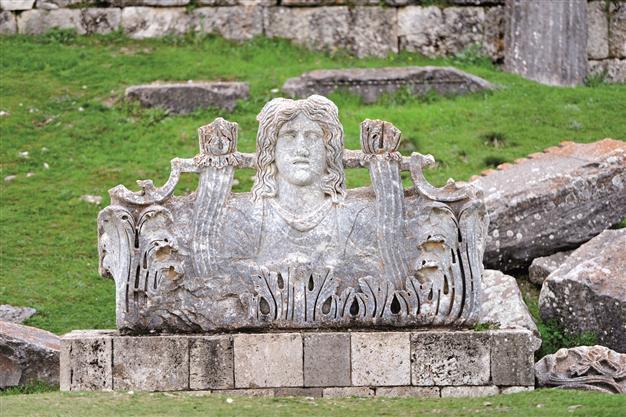Two-millenia-old Aizanoi inspiring Istanbul bourse
KÜTAHYA - Anatolia News Agency

The ancient city of Aizanoi has a round-shaped structure dating back to the second century A.D. It was the Macellum building, the world’s first stock exchange. AA photo
Turkey’s newly formed Borsa Istanbul (BIST) might be experiencing a period of effervescence as it bursts onto the world financial scene, but its roots go back much further than its immediate predecessor, the Istanbul Stock Exchange (İMKB). The inspiration for the bourse goes all the way back to antiquity and the world’s “oldest stock exchange,” Aizanoi in present-day Kütahya.Aizanoi, which is located in the inner Aegean province’s Çavdarhisar district, is now being used in the promotions for BIST, a recent amalgamation of the İMKB and the Istanbul Gold Exchange.
Archaeologists working at the site in 1971 discovered inscriptions indicating the existence of a stock exchange during the Roman era. According to the inscriptions, a slave’s price was equal to a donkey, while a horse was worth three slaves.
Notably, a round-shaped structure dating back to the second century A.D. contains a copy of a paper from Emperor Diocletian that was written in 301 A.D. that outlined regulations on sales prices for goods in the market. Because of the document, many have claimed that Aizanoi possessed the world’s first stock market in its Macellum building.
The head of the Aizanoi excavations, Pamukkale University Assistant Professor Elif Özer, said the world’s first stock exchange was one of the most important structures in the ancient city. She said the round structures and inscriptions in the Macellum area, known as the stock exchange building, had become a current issue during works for BIST and had drawn the attention of brokers, bankers and investors.
“In the round building, which was unearthed in the ancient city after the Gediz earthquake in 1970, there is the Narh legal decision that the Emperor Diocletian issued in order to prevent an abnormal increase of prices and take inflation under control. The legal decision was the equivalent of economic recovery programs that are taken after each economic problem today,” she said.
She said some prices in the legal decision had drawn attention. “For example, the daily wage of a painter was 150 dinars, while the daily wage of a jurist or lawyer was 250 dinars. The wage of educators is one of the lowest. The ceiling price in ancient times continues to be an inspiration today. This is why Aizanoi is used in promotions for the Istanbul Stock Exchange (İMKB), which recently became BIST.”
Dating back to 3,000 BC
Aizanoi is 57 kilometers away from the provincial center of Kütahya and is known as the second Ephesus thanks to its 20,000-person-capacity amphitheater, 13,500-person-capacity stadium, a bath, a street with pillars, a necropolis and the world’s first stock exchange.
The name “Aizanoi” comes from the mythological hero “Azan,” while the city is believed to date back to 3000 B.C. During the Hellenistic era, Aizanoi was seized by the Pergamon Kingdom and Bithynia from time to time. The city later fell under Roman rule but gradually declined in importance in the early Byzantine era.
German archaeologists had been conducting excavations in the ancient city since 1970, but the dig was transferred to the control of Denizli’s Pamukkale University in 2011.

















